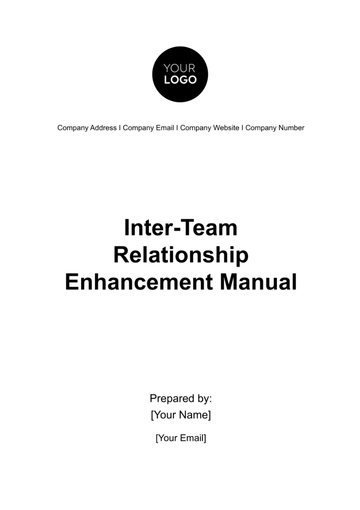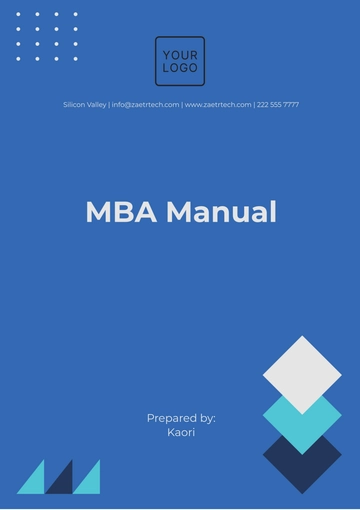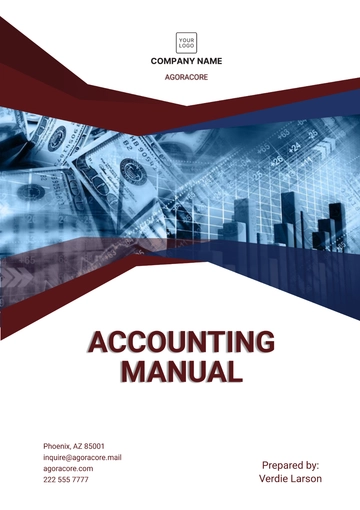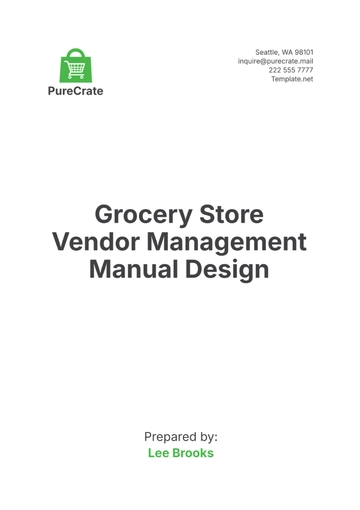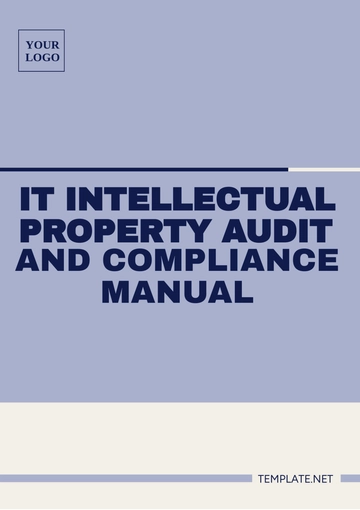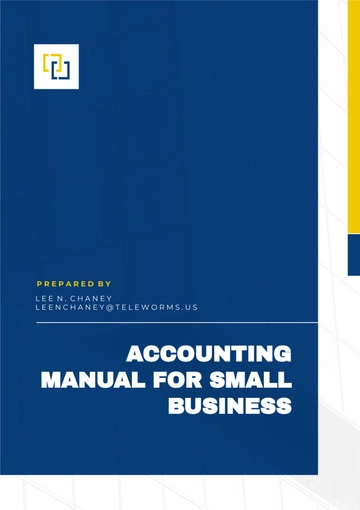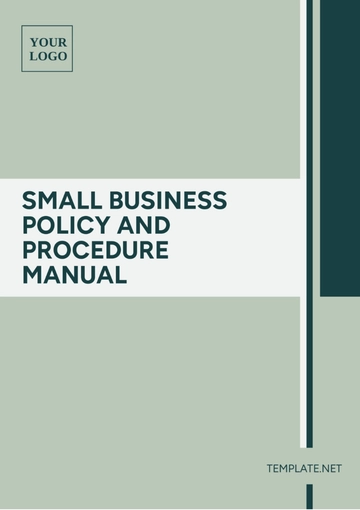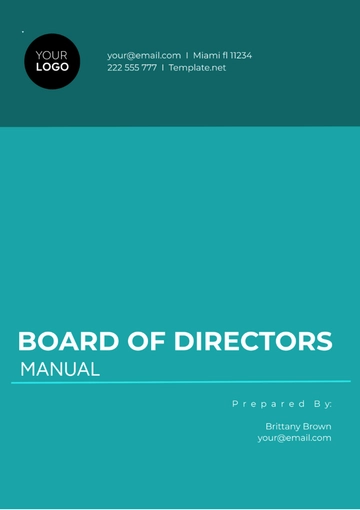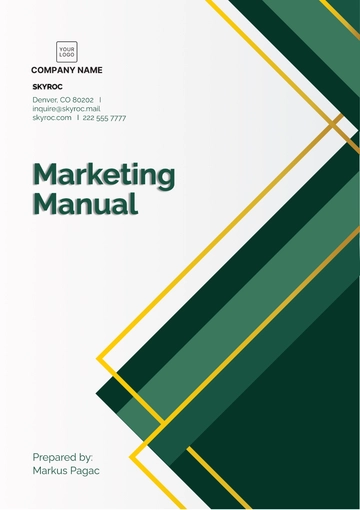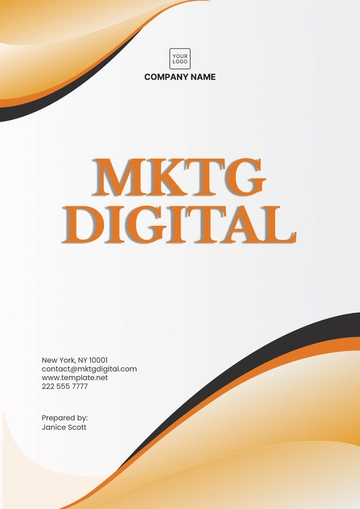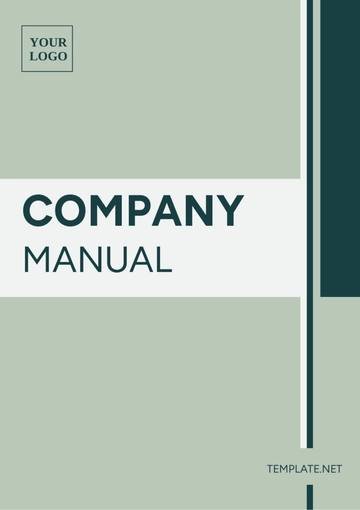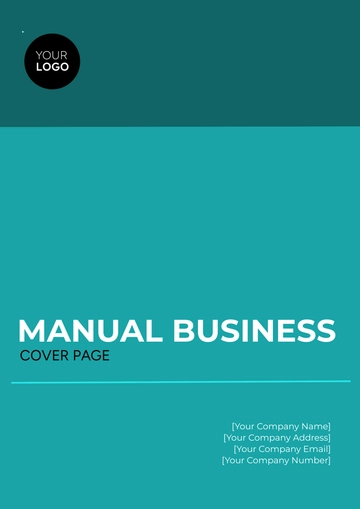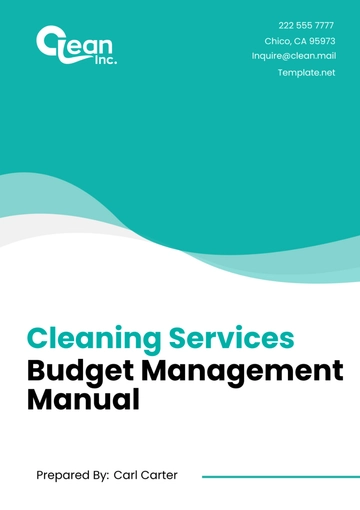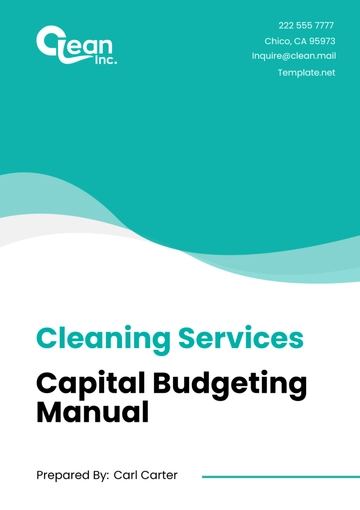Free Cleaning Services Capital Budgeting Manual
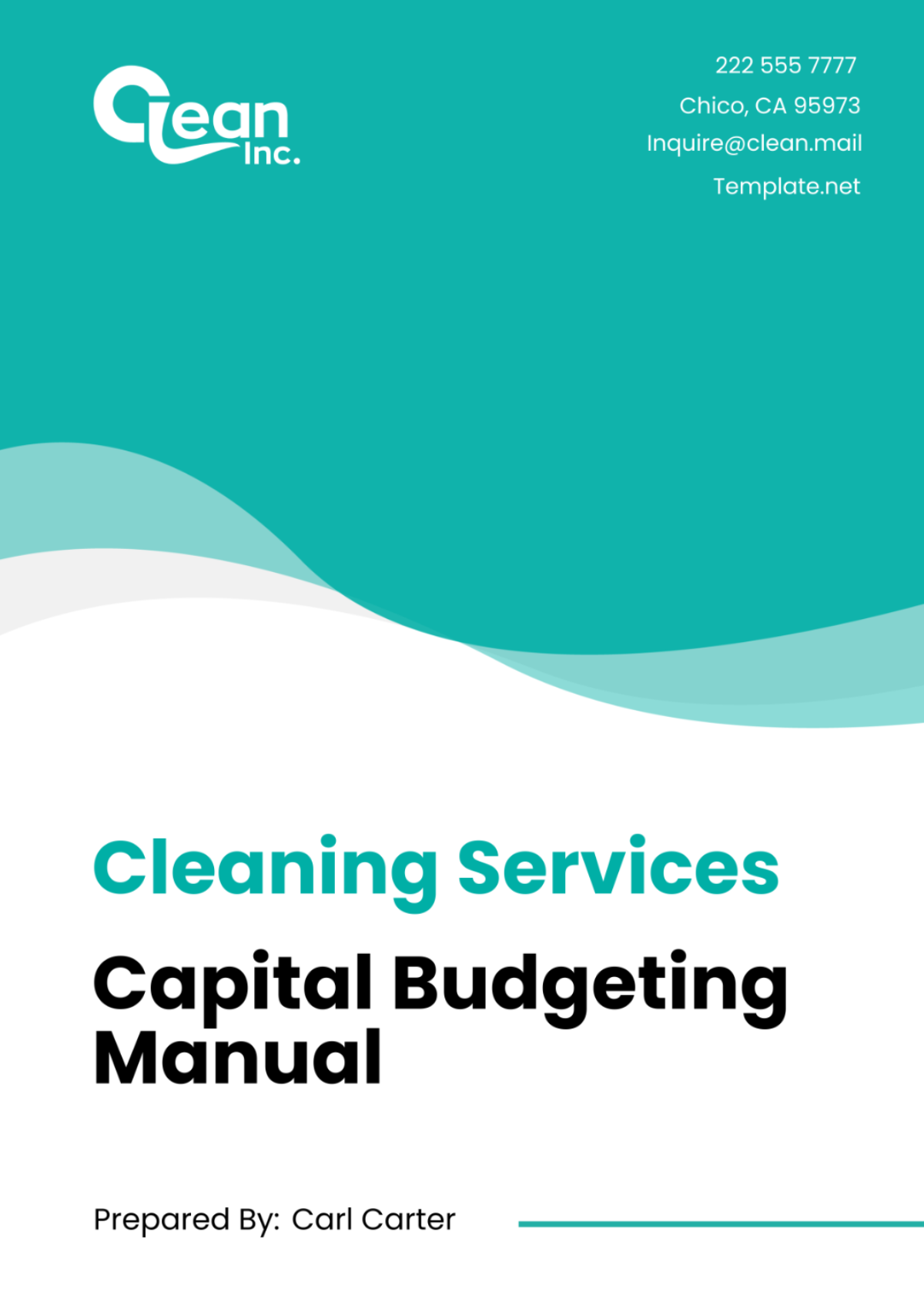
Introduction
Welcome to the Capital Budgeting Manual of [Your Company Name]. This manual is designed as a comprehensive guide for our management and financial teams to navigate through the complexities of capital budgeting, ensuring that our long-term investments drive us toward achieving our strategic goals and enhancing our market position.
Purpose of the Manual: To provide a structured framework for evaluating, selecting, and managing capital investments in cleaning equipment, technology, and business expansion projects.
Scope and Application: This manual applies to all capital budgeting decisions made within [Your Company Name], including investments in new technology, equipment, and expansion initiatives for your cleaning services.
Definitions and Key Concepts in Capital Budgeting:
Capital Budgeting: The process of analyzing and selecting long-term investments that are in alignment with the strategic objectives of the company.
Capital Expenditures (CapEx): Funds used by a company to acquire, upgrade, and maintain physical assets.
Operational Expenditures (OpEx): The ongoing costs for running product, business, or system.
Chapter 1: Understanding Capital Budgeting
Introduction to Capital Budgeting
Capital budgeting is a crucial financial tool for [Your Company Name], enabling us to determine the worth of long-term investments. These decisions affect the company's operational capabilities, competitive positioning, and profitability for years to come.
Importance of Capital Budgeting for Cleaning Services
For a cleaning services company, capital budgeting is vital for:
Ensuring that investments in equipment and technology yield positive returns.
Managing the allocation of financial resources effectively.
Planning for sustainable business growth and expansion.
Difference Between Capital and Operational Expenditures
Capital Expenditures (CapEx) are the company's investments in physical assets or projects that will generate value in the future, such as purchasing new cleaning equipment. Operational Expenditures (OpEx), on the other hand, are the day-to-day expenses that are necessary to keep the business running, such as salaries, utilities, and cleaning supplies.
Chapter 2: Capital Budgeting Process
The capital budgeting process in [Your Company Name] involves several key steps from the identification of potential projects to their execution and post-implementation review. This systematic approach ensures that all projects undergo thorough evaluation and align with our strategic goals.
Identification of Capital Budgeting Projects
Projects can be identified based on the need for:
Expansion: Opening new locations or extending services to new markets.
Equipment Upgrade: Replacing old equipment with more efficient technology.
Technology Investment: Implementing new software or systems to improve service delivery.
Project Evaluation and Selection
Cost-Benefit Analysis: This involves comparing the projected costs of a project against the benefits it is expected to bring. Only projects with a net positive benefit are considered for approval.
Risk Assessment: Evaluating the potential risks associated with each project, including financial, operational, and market risks.
Chapter 3: Financing Options for Capital Investments
To finance capital investments, [Your Company Name] explores a variety of options to find the most cost-effective and strategic fit.
Internal Financing vs. External Financing
When speaking of Internal Financing, we refer to processes that include the utilization of the company's accumulated savings. This could also involve reallocating funds from areas within the business that are deemed less critical to its operation. On the other hand, External Financing could take shape in various forms that might extend beyond the company. One possible method is by procuring loans from financial institutions or other lenders. Another approach could be by leasing equipment, which basically means renting the necessary machinery or technology needed for the business without having to buy it outright, thus helping to manage and allocate resources effectively.
Types of Loans and Interest Rates
Type of Loan | Interest Rate | Terms |
|---|---|---|
Term Loan | 6-8% | 5-10 years |
Equipment Financing | 5-7% | Up to the useful life of the equipment |
Line of Credit | Variable, currently around 7% | Revolving |
Leasing vs. Buying Equipment
When making a decision between leasing and buying, a detailed comparison is carried out. This comparison looks into factors that encompass the total cost of ownership. Primarily, this comparison includes the initial upfront costs that are required as a part of the decision-making process. Next, it also considers the ongoing maintenance costs that would be borne as a part of the ownership. Furthermore, potential tax benefits, that could be reaped depending on the option chosen, are also a chief part of this comparison. Thus, in these ways, decisions on whether to lease or to buy are effectively drawn.
Chapter 4: Evaluating Capital Investments
Evaluating capital investments is crucial for ensuring that [Your Company Name] allocates resources to projects with the highest potential for return. We use several methods to assess the viability of these investments.
Cash Flow Analysis
Overview:
Cash Flow Analysis is a fundamental technique used by [Your Company Name] to assess the financial viability of a capital investment project over its expected life. This analysis involves meticulously forecasting the cash inflows (revenues or savings) and outflows (costs or investments) associated with the project. By understanding the timing and magnitude of these cash flows, the company can determine the net cash flow for each period, usually on an annual basis.
Procedure:
Forecast Initial Investment Outlays: Identify all initial costs associated with starting the project, including but not limited to, purchase of equipment, installation costs, and initial working capital requirements.
Estimate Operating Cash Flows: For each year of the project's life, estimate the cash inflows from operations. This includes revenues from sales or services and any savings in operating costs, minus operating expenses and taxes.
Calculate Terminal Cash Flow: Estimate the net cash inflow at the end of the project's life, which may include salvage value of assets, recovery of working capital, and any final year's operating cash flow.
Adjust for Non-Cash Expenses: Add back any non-cash expenses such as depreciation or amortization, as these affect taxable income but do not impact cash flow directly.
Application:
This method is crucial for determining the timing and scale of cash flows, helping [Your Company Name] evaluate the liquidity aspect of a project and its impact on the company's cash reserves. It forms the basis for further financial analysis, including the computation of NPV and IRR.
Net Present Value (NPV)
Overview:
Net Present Value (NPV) is a core financial metric used in capital budgeting to assess the profitability of an investment. It represents the difference between the present value of cash inflows and the present value of cash outflows over the project's lifetime. NPV accounts for the time value of money, providing a dollar amount that signifies how much value the project is expected to add to [Your Company Name].
Procedure:
Determine the Discount Rate: Establish the appropriate discount rate, which reflects the project's risk and the opportunity cost of capital.
Calculate Present Value of Cash Flows: For each period, discount the net cash flow back to its present value using the discount rate.
Sum Present Values: Sum all the present values of the projected cash flows, including the terminal value.
Subtract Initial Investment: Deduct the initial project cost from the sum of discounted cash flows to arrive at the NPV.
Application:
A positive NPV indicates that the project is expected to generate value in excess of its costs, making it a potentially profitable investment. [Your Company Name] prioritizes projects with higher NPV values, as they are considered to add more value to the company, assuming the NPV calculations incorporate all relevant cash flows and an appropriate discount rate.
Internal Rate of Return (IRR)
Overview:
The Internal Rate of Return (IRR) is a capital budgeting metric used to evaluate the profitability of potential investments. It is the discount rate at which the net present value of all cash flows (both positive and negative) from a project equals zero. In simpler terms, IRR is the break-even interest rate that makes the project neither lose nor gain value.
Procedure:
List Projected Cash Flows: Include the initial investment (as a negative number) and the expected annual net cash flows.
Use Financial Software: Utilize a financial calculator or spreadsheet software, inputting the cash flows to solve for the IRR.
Compare to Required Rate of Return: The IRR is then compared to [Your Company Name]'s required rate of return or hurdle rate to determine the project.
Chapter 5: Project Implementation and Monitoring
Once a project is approved, [Your Company Name] moves to the implementation phase, ensuring that the execution aligns with the planned objectives and budgets.
Project Scheduling and Management
A detailed project timeline is developed, outlining key milestones and responsibilities. Project management tools and software are used to track progress and ensure timely completion.
Budgeting and Cost Control
A project budget is prepared, which carefully details all the projected costs associated with the entire completion process of the project. To ensure that all expenditures are kept in check and any unnecessary, extraneous costs are pruned, regular financial reviews are put in place. These reviews serve the purpose of monitoring the dispensation of funds and also implementing measures to control costs, if and when it becomes necessary to initiate such moves for the sake of the project's financial health.
Performance Measurement and Evaluation
Performance indicators have been established for the specific purpose of evaluating the success of the project. These performance indicators are determined by comparing the project's progress and outcomes against its originally stated objectives. Included in these performance indicators are measurements of financial returns, which assess the profitability or cost-effectiveness of the project, operational improvements, which evaluate any increases in efficiency or productivity, and lastly, customer satisfaction metrics, which gauge the level of satisfaction and positive experience of the end-users or customers.
Dealing with Project Delays and Overruns
The strategies that can be used to affectively mitigate any potential delays and cost overruns in a project include making plans for unexpected contingencies that may arise during the course of the project's execution. This could include predetermining alternative approaches or solutions to potential issues. It also includes implementing effective risk management techniques. That could involve identifying potential risks early on, assessing their possible impact, and developing strategies to control or reduce them. Additionally, maintaining flexible project management practices plays a crucial role in this process. This involves the use of adaptive strategies and practices that can be adjusted and modified as needed based on the dynamic nature of the project or unexpected changes or challenges that may become apparent over time.
Chapter 6: Technology in Capital Budgeting
[Your Company Name] leverages technology to enhance the efficiency and accuracy of our capital budgeting process.
Software Tools for Capital Budgeting
Various software tools are utilized for financial modeling, risk assessment, and project management, allowing for more informed decision-making and streamlined project execution.
Impact of Technology on Project Evaluation
Technology plays a pivotal role in allowing the monitoring and analysis of various data and information in real time, enhancing the flexibility and promptness of making decisions. Moreover, it also increases the capability of adapting to altering circumstances swiftly and efficiently.
Keeping Up with Technological Advancements
Within the company, there is an endorsement and encouragement for the continual process of learning and adopting new advancements in technological tools and platforms. This emphasis on learning and adjustment is in place so that the business can maintain an advantage over its competitors, ensuring that we are always at the forefront of technological changes and are adaptable to the ever-evolving digital landscape.
Chapter 7: Risk Management in Capital Budgeting
Risk management is an integral part of the capital budgeting process, ensuring that [Your Company Name] is prepared for uncertainties.
Identifying and Assessing Risks
Comprehensive Risk Identification:
The first step in risk management is to conduct a thorough risk identification exercise. This involves gathering input from all stakeholders, including project managers, financial analysts, operational staff, and even customers when applicable. The goal is to compile a comprehensive list of potential risks that could impact the project, categorized into financial, operational, market, and other relevant types.
Risk Assessment Framework:
Once identified, each risk is assessed for its likelihood of occurrence and potential impact on the project. [Your Company Name] employs a structured risk assessment matrix, which helps in prioritizing risks based on their severity. This matrix classifies risks into categories such as 'High', 'Medium', and 'Low', both in terms of their probability and their impact.
Type | Details |
|---|---|
Financial Risks | Could include fluctuations in interest rates affecting loan costs, unexpected increases in project costs, or liquidity constraints. |
Operational Risks | Might involve challenges in project execution, such as delays, labor shortages, or technological failures. |
Market Risks | Encompass changes in customer demand, competitive pressures, or regulatory changes affecting market dynamics. |
Quantitative and Qualitative Analysis:
For each high-priority risk, a more detailed analysis is conducted. Quantitative methods, such as sensitivity analysis and scenario planning, are used alongside qualitative insights from experienced team members to understand the potential variations in project outcomes and their likelihoods.
Strategies for Risk Mitigation
Developing a Risk Mitigation Plan:
For each identified risk, [Your Company Name] develops specific strategies aimed at either reducing the probability of the risk occurring or minimizing its impact should it occur. This plan is an integral part of the project's overall strategy and is monitored and updated throughout the project lifecycle.
Diversification of Investments: Spreading resources across multiple projects or sectors to reduce the impact of a single failure.
Insurance: Purchasing insurance coverage for certain risks, such as property damage, liability, or loss of key personnel, to transfer risk.
Strategic Partnerships: Entering into partnerships or alliances that can offer synergies and buffer against specific risks, such as supply chain disruptions.
Cost-Benefit Analysis of Mitigation Strategies:
Each mitigation strategy is evaluated for its cost-effectiveness. This involves comparing the cost of implementing the strategy against the potential benefit in terms of reduced risk impact or likelihood. Only cost-effective strategies are included in the risk management plan.
Contingency Planning
Developing Contingency Plans:
Contingency plans are developed for risks that are critical and have a high potential impact. These plans detail specific steps to be taken if a risk event occurs, ensuring that [Your Company Name] can respond quickly and effectively to minimize disruptions.
Outline of Response Actions: For each critical risk, a clear action plan is outlined, including roles and responsibilities, timelines, and resources required.
Communication Plans: Detailed communication strategies are developed to ensure timely and accurate information sharing with all stakeholders, including employees, customers, and suppliers, in the event of a risk occurrence.
Regular Reviews and Updates: Contingency plans are living documents that are reviewed and updated regularly based on new information or changes in the project scope or external environment.
Training and Preparedness:
[Your Company Name] invests in training for key personnel on the execution of contingency plans. Simulation exercises and drills are also conducted to ensure readiness and to refine the plans based on practical insights.
Chapter 8: Regulatory Compliance and Ethical Considerations
Compliance with legal and regulatory requirements is non-negotiable in our capital budgeting decisions. Ethical considerations are also at the forefront of our decision-making process.
Compliance with Local, State, and Federal Regulations
Every project that is undertaken is subjected to evaluation to ensure that it adheres to all the relevant regulations. These regulations range from those pertaining to environmental laws, ensuring that projects abide by proper guidelines and are not damaging to the environment, to labor standards, which are in place to protect workers and ensure fair work practices. Moreover, financial reporting requirements also form a core part of these regulations, necessitating that all financial activities associated with the projects are documented and reported accurately and transparently.
Environmental Considerations and Sustainability
When it comes to the process of capital budgeting, sustainable practices are worked into this process in an integrated manner. Moreover, when making decisions on which projects to invest in or support, there is a preference towards those projects that can make a significant contribution in reducing their impact on the environment, as well as those that aim to manage resources in an efficient manner as a part of their operational structure.
Ethical Practices in Capital Budgeting
At [Your Company Name], we pride ourselves on adhering to the highest possible ethical standards in all of our business interactions and transactions. These principles not only guide our day-to-day operations but also play a fundamental role in shaping our strategic investment decisions. We are steadfast in our commitment to uphold corporate responsibility and express this through our consistent demonstration of ethical conduct. In everything we do, we strive to reflect the values of transparency, integrity, and respect for the interests of all stakeholders involved, reinforcing our dedication to maintaining our robust ethical framework at all times. As a leader in our industry, we recognize the influence we wield, and we believe in harnessing it to set an example of responsible and ethical business practices.
Chapter 9: Case Studies
Case Study 1: Green Cleaning Technology Implementation
Background:
Faced with increasing demand for environmentally friendly services, [Your Company Name] identified an opportunity to invest in green cleaning technology. This initiative aimed to not only meet market demand but also reduce long-term operational costs through more efficient resource use.
Project Evaluation:
The capital budgeting team conducted a thorough analysis, including cash flow projections, NPV, and IRR calculations. A significant upfront investment was required for purchasing eco-friendly equipment and training staff. However, the analysis projected substantial long-term savings and a competitive market advantage.
Risk Management:
Risks identified included the potential for technology obsolescence and uncertain market reception. Mitigation strategies involved flexible procurement contracts and an extensive market analysis to gauge customer preferences.
Outcome:
The project was launched and met its 2-year payback period target, with ongoing operational savings exceeding initial forecasts. Customer feedback was overwhelmingly positive, leading to increased market share.
Lessons Learned:
Thorough market research is crucial for aligning investments with customer values.
Investing in staff training ensures the effective adoption of new technologies.
Case Study 2: Expansion into New Markets
Background:
Seeking growth, [Your Company Name] decided to expand its services to a new geographic region. This required significant capital investment in marketing, new facilities, and hiring local staff.
Project Evaluation:
A detailed feasibility study was conducted, revealing strong demand in the target market but also highlighting potential regulatory and logistical challenges. Financial models showed a promising NPV, with a breakeven point within the first three years.
Risk Management:
To address the identified risks, the company decided to enter a joint venture with a local firm, reducing the burden of regulatory compliance and benefiting from the partner's established presence and knowledge of the local market.
Outcome:
The expansion project was more successful than anticipated, achieving profitability in the second year. The partnership approach facilitated smoother entry into the new market and accelerated customer acquisition.
Lessons Learned:
Partnerships can be a powerful strategy for mitigating entry risks in new markets.
Flexibility and local knowledge are key to overcoming regulatory and logistical challenges.
Conclusion
The manual, also known as The Capital Budgeting Manual, is not just an ordinary document. Instead, it is a living, breathing guide designed specifically for [Your Company Name]. Its main aim is to direct and provide assistance in navigating the intricacies associated with making crucial long-term investment decisions. We highly encourage every member of our corporation to strictly adhere to the principles and processes that have been clearly outlined in this extensively prepared manual. By doing so, we, as a collective body, aim to establish a strategic allocation of our vast resources. The ultimate goal is to not only promote consistent growth but also ensure a system that enhances and sustains profitability in the long run. This objective is pivotal to our corporation's stability and success amidst rapidly evolving business environments.
- 100% Customizable, free editor
- Access 1 Million+ Templates, photo’s & graphics
- Download or share as a template
- Click and replace photos, graphics, text, backgrounds
- Resize, crop, AI write & more
- Access advanced editor
Master your investments with the Cleaning Services Capital Budgeting Manual Template from Template.net. Fully customizable and editable via our Ai Editor Tool, this template guides strategic financial planning and decision-making. Ideal for optimizing your cleaning business's capital expenditures, it's an indispensable resource for financial growth. Discover it exclusively at Template.net.
